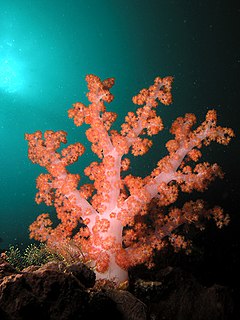
Conodonts are an extinct group of agnathan (jawless) vertebrates resembling eels, classified in the class Conodonta. For many years, they were known only from their tooth-like oral elements found in isolation and now called conodont elements. Knowledge about soft tissues remains limited. They existed in the world's oceans for over 300 million years, from the Cambrian to the beginning of the Jurassic. Conodont elements are widely used as index fossils, fossils used to define and identify geological periods. The animals are also called Conodontophora to avoid ambiguity.

Octocorallia is a subclass of Anthozoa comprising around 3,000 species of water-based organisms formed of colonial polyps with 8-fold symmetry. It includes the blue coral, soft corals, sea pens, and gorgonians within three orders: Alcyonacea, Helioporacea, and Pennatulacea. These organisms have an internal skeleton secreted by mesoglea and polyps with eight tentacles and eight mesentaries. As with all Cnidarians these organisms have a complex life cycle including a motile phase when they are considered plankton and later characteristic sessile phase.
The Pander Society is an informal organisation founded in 1967 for the promotion of the study of conodont palaeontology. It publishes an annual newsletter. Although there are regular meetings of the Pander Society, at the Annual Meeting of the Geological Society of America, at European Conodont Symposia, and elsewhere, any meeting of three or more "Panderers" is considered an official meeting of the "Pander Society". The society is headed by the Chief Panderer, currently Maria Cristina Perri of the Università di Bologna. The society confers two awards, the Pander Medal for a lifetime of achievement in conodont palaeontology, and the Hinde Medal for an outstanding contribution to conodont palaeontology by a young Panderer.
Periodon is a genus of conodonts which existed in what is now Canada, Iran, Argentina, China, Russia, and the United States during the Ordovician Period. It was described by Hadding in 1913, and the type species is P. aculeatus.
Maurits Lindström was a Swedish geologist and paleontologist. Lindströms initial work was divided among two topics conodont paleontology and the structural geology of the Scandinavian Caledonides in Lappland.
Proconodontida is an order of conodonts.
Ozarkodina is an extinct genus of conodonts in the family Spathognathodontidae.
Idiognathodus is an extinct conodont genus in the family Idiognathodontidae.
Proconodontidae is an extinct family of conodonts in the order Proconodontida.
Proconodontus is an extinct genus of conodonts in the family Proconodontidae. The specimens are found in Cambrian formations.
Gondolellidae is an extinct family of conodonts in the order Ozarkodinida. There are three subfamilies: Mullerinae, Neogondolellinae and Novispathodinae.
Gapparodus is an extinct genus of conodonts in the family Furnishinidae. Gapparodus gapparites is a species of the Early Cambrian of Shuijingtuo Formation in China.

Acanthodus is an extinct genus of conodonts.
Kallidontus is an extinct genus of conodonts.

Variabiloconus is an extinct genus of conodonts.
Baltoniodus is an extinct genus of conodonts.
Microzarkodina is an extinct genus of conodonts mainly from the Middle Ordovician of Baltoscandia. The Microzarkodina apparatus probably consisted of 15 or 17 elements: four P, two or four M and nine S elements. The S elements include different Sa, Sb1, Sb2, and Sc element types.
Neospathodus is an extinct genus of conodonts.
Protoconodonts are an extinct taxonomic group of conodonts or, possibly, Chaetognaths.
Protohertzina is a genus of conodonts or, possibly, Chaetognaths, found at the beginning of the Cambrian explosion.


